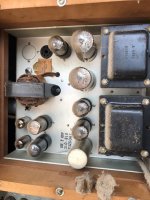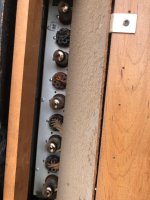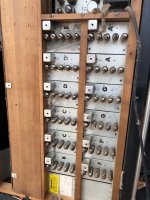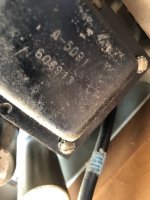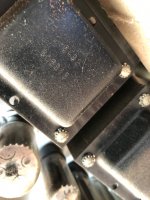Another "Ultimate" in the serie...
A revamping of a prototype I made 18 years ago 🙄😱
A simple and compact mono block amp that waited, taking dust on a shelf, in need of reworking and improvements.
The beast, once refurbished today. The pen gives the scale :
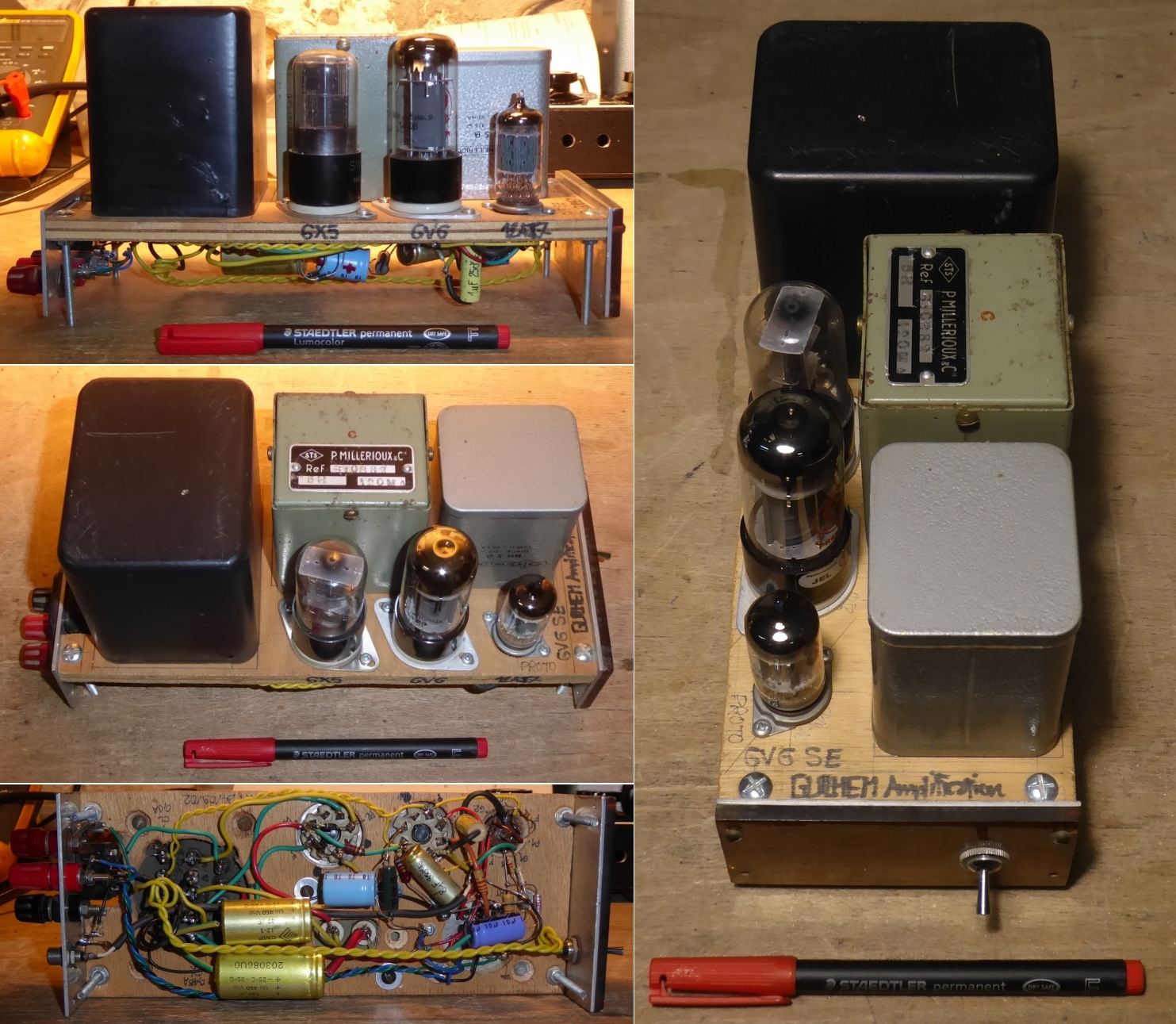
I came to 2 possibilities with the parts available :
One with decoupling the preamp stage cathode before taking FB loop :

The other with no decoupling the preamp stage cathode and direct FB loop :

The PSU remains the same for both :
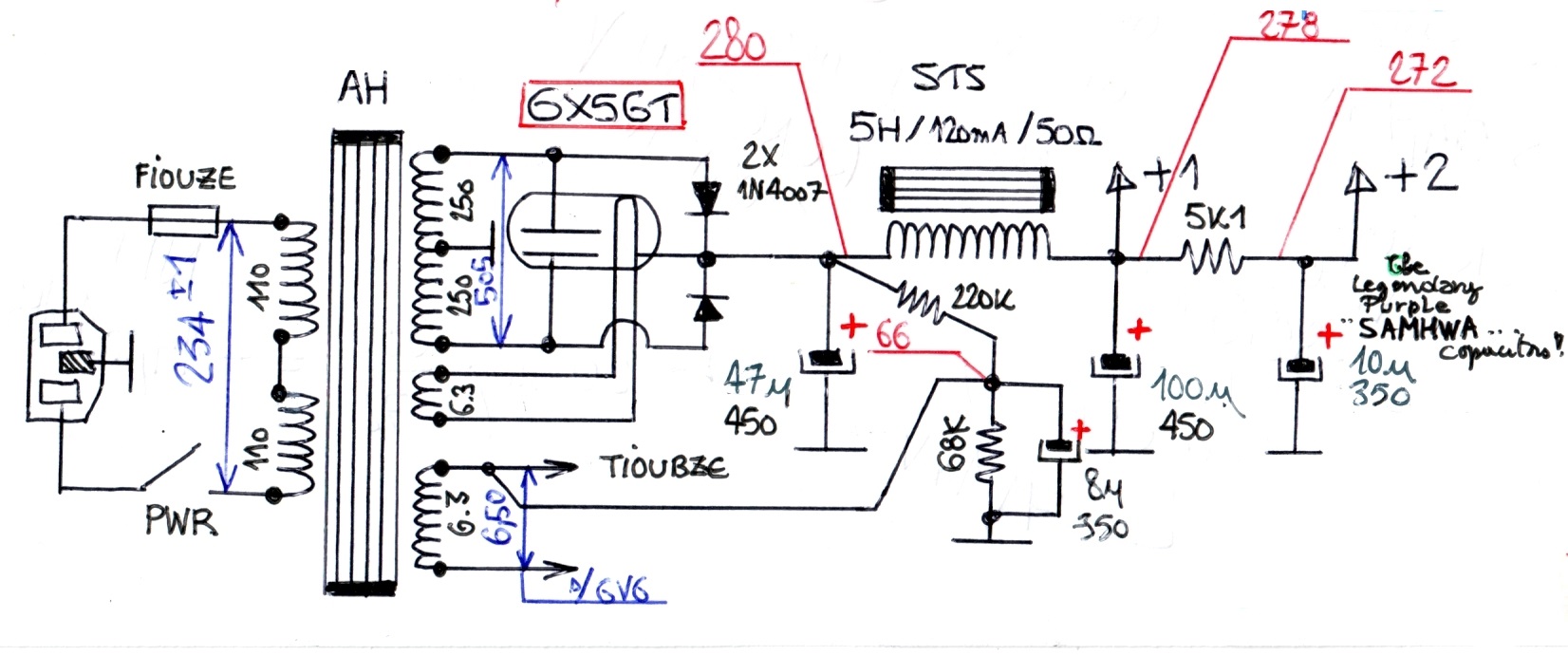
Comparaison side-to-side of the square wave oscillograms, in exact same testing conditions :

I went for the other, the non-decoupled, direct FB loop circuit. All things equal otherwise :
- it has a reduced bandwidth : 10Hz-40KHz instead of 60KHz. Given that the bass extension without distortion is 20Hz, no need to go so high.
- the total FB is reduced to 10dB instead of 14dB for the same input sensivity (0.7VRMS). Less FB gives less performance here, but smoother square waves, so possibly less harshness in the harmonics.
A friend of mine will come soon so we will be able to make THD, IM and harmonic spectrum analysis thanks to its software.
So wait and See if that choice is good or not... 😱😉
A+!
A revamping of a prototype I made 18 years ago 🙄😱
A simple and compact mono block amp that waited, taking dust on a shelf, in need of reworking and improvements.
The beast, once refurbished today. The pen gives the scale :

I came to 2 possibilities with the parts available :
One with decoupling the preamp stage cathode before taking FB loop :

The other with no decoupling the preamp stage cathode and direct FB loop :

The PSU remains the same for both :

Comparaison side-to-side of the square wave oscillograms, in exact same testing conditions :

I went for the other, the non-decoupled, direct FB loop circuit. All things equal otherwise :
- it has a reduced bandwidth : 10Hz-40KHz instead of 60KHz. Given that the bass extension without distortion is 20Hz, no need to go so high.
- the total FB is reduced to 10dB instead of 14dB for the same input sensivity (0.7VRMS). Less FB gives less performance here, but smoother square waves, so possibly less harshness in the harmonics.
A friend of mine will come soon so we will be able to make THD, IM and harmonic spectrum analysis thanks to its software.
So wait and See if that choice is good or not... 😱😉
A+!
Could you make something with this thing? It’s from a organ that has two 12” jenson speakers. Not sure if it’s a one or two channel amp.
View attachment 848830
View attachment 848831
View attachment 848832
View attachment 848833
View attachment 848834
Yes @carlthess40, It's certainly possible to do something with that, but the first thing that I would consider is restoring that organ to make it work, for sure ! Think Booker-T and the MG's "Green Onions"; The Backyard Heavies "Soul Junction"... 😎😎😎
A+!
Very nice prototype. It will be interesting to see the harmonic spectrum when you get it.
Thanks @Pano ! I had this measurement facility, until my old WXP left me definetly... But I'll have to find a substitution now.
A+!
Software is easy now, but you do need the hardware.
This reminds me of the SEP KT88 of Jean Hiraga from so many years ago but I think that had a UL tap on the transfo, right?
This reminds me of the SEP KT88 of Jean Hiraga from so many years ago but I think that had a UL tap on the transfo, right?
Software is easy now, but you do need the hardware.
This reminds me of the SEP KT88 of Jean Hiraga from so many years ago but I think that had a UL tap on the transfo, right?
Exact, @Pano.
I did not took the time for changing that software hardware history. My previous one worked so well... 🙁 Here's the hardware I built for it, that allowed all measurements, amps THD-Spectrum, speakers TS and enclosure :

But you are right : I have to reinstate that stuff ASAP ! 😱
Yes, JH's circuit had an UL tap. It was first described in L'Audiophile N°14 in 1982 (I got the original edition... Stolen at my University Bibliotheque at that time when I was a student... Shhht ! 😉 )
My Ultimate KT120 recent thread describes a similar amplifier otherwise... 🙄
The ultimate KT120
A+!
Very nice! Looks well made and laid out. Should be quick and eay to use.  A good friend here gave me a Pete Millet interface for soundcards which is handy for doing measurements.
A good friend here gave me a Pete Millet interface for soundcards which is handy for doing measurements.
I'll look at the KT120 thread. I had been wondering if the old SE KT88 circuit might fit a KT120 or 150.
 A good friend here gave me a Pete Millet interface for soundcards which is handy for doing measurements.
A good friend here gave me a Pete Millet interface for soundcards which is handy for doing measurements. I'll look at the KT120 thread. I had been wondering if the old SE KT88 circuit might fit a KT120 or 150.
AFAIK, the KT120 and 150 are extended plate dissipation versions of the KT88 and 6550, but with the same curves network (or nearly). My U-KT120 for the moment uses 6550 and KT88 that I had on hand... 😉
A+!
A+!
tubelectron,
Your power supply schematic has the 1N4007 diodes in Parallel with the tube rectifier.
All of the current would go through the diodes because they have a very low voltage drop; and none of the current would go through the tube rectifier plates.
Did you intend to put the 1N4007 diodes in series with the tube rectifier plates? . . .
Secondary lead # 1, 1N4007 # 1, tube rectifier plate.
Secondary lead # 1, 1N4007 # 1, the other tube rectifier plate.
The amplifier will probably be more stable at 10 dB negative feedback, with various types of loudspeaker loads (dominant resistive, capacitive, and inductive reactances at various frequencies).
Your power supply schematic has the 1N4007 diodes in Parallel with the tube rectifier.
All of the current would go through the diodes because they have a very low voltage drop; and none of the current would go through the tube rectifier plates.
Did you intend to put the 1N4007 diodes in series with the tube rectifier plates? . . .
Secondary lead # 1, 1N4007 # 1, tube rectifier plate.
Secondary lead # 1, 1N4007 # 1, the other tube rectifier plate.
The amplifier will probably be more stable at 10 dB negative feedback, with various types of loudspeaker loads (dominant resistive, capacitive, and inductive reactances at various frequencies).
- Home
- Amplifiers
- Tubes / Valves
- The ultimate 6V6
